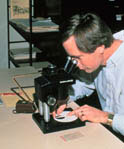
 |
||
 |
||
 |

Laboratory Studies
Studying
the Discoveries
In the
lab, archaeologists take a closer look at their finds. Archaeologists
who specialize in a certain types of objects or in a particular time period
study the different kinds of artifacts.
These experts include lithic
specialists, ceramic
specialists, archaeozoologists,
and archaeobotanists.
By studying the remains, the archaeologists can begin to explain what humans were doing at the site:
- what they ate
- what kinds of plants and animals they used
- what types of containers and other tools they made and used
- how they decorated-objects
- who they interacted with
Archaeologists will never be able to find every piece of that puzzle, but with their help, we can find out more about the lives of people who lived before us.
Storing
the Finds Safely
Once
they have finished studying the artifacts and remains, the archaeologists
carefully place them in boxes and cabinets and store them in the Museum's
storerooms. These rooms are fitted with special cabinets and environmental
controls that regulate temperature and humidity to help protect and preserve
the objects.
Records
describing each item and its location are made to help the archaeologists
keep track of the collections.
|
|
Copyright© 2000 Illinois State Museum Society